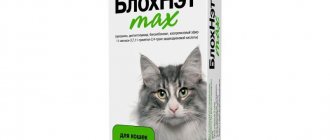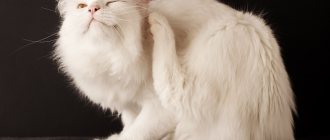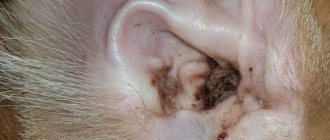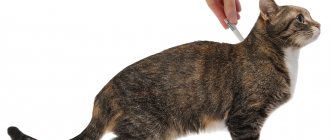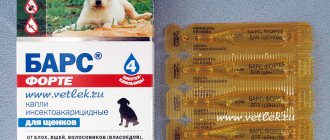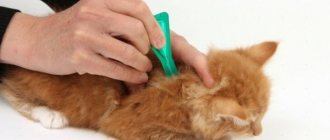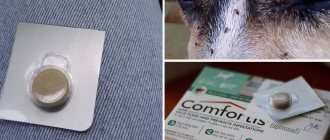Description of the cat lice eater
The cat lice eater looks like a flat beige bug several centimeters long (usually 1-2 cm).
The structural features of the cat lice eater are as follows:
- wings are missing;
- the belly is elongated, oval-shaped, covered with bristles;
- the breast is underdeveloped, divided into three segments;
- three pairs of legs are equipped with hooks that dig into the cat’s skin;
- the head is disproportionately large, has short mustaches;
- mouth is large;
- triangular eyes are underdeveloped;
- color varies from whitish to light red.
The exoparasite feeds on the animal’s blood, dead epidermis, and particles of fur.
The female lays 100-120 eggs on the fur, attaching them to the hairs with sticky mucus.
The larvae go through 3 stages of maturation in 28 days, turning into adults. Rapid reproduction occurs in autumn and winter. Lice eaters, unlike lice and fleas, cannot survive without the host's body.
Causes and symptoms of infection
A cat can become infected with lice eaters either from its infected relatives or by catching infected prey: a mouse, a rat, etc. Infection can occur during a walk, and even at home if a person brings the parasites on shoes or clothes.
Symptoms of infection are:
- constant itching and attempts by the animal to “gnaw” insects from the fur;
Severe itching may be a symptom of lice infestation
- scratching on the skin;
- with severe infection and in advanced cases - baldness;
- lethargy, anemia, weakness and irritability;
- inflamed skin, often a rash;
- sometimes insomnia occurs.
Having noticed lice eaters in a cat's fur, it is quite possible to mistake them for fleas. To distinguish lice eaters from fleas, you need to heat the cat's fur (this can be done with a special lamp, near a battery, or simply under the sun's rays). Lice eaters strive for warmth and will crawl to the surface, unlike fleas.
Video: how to tell if a cat has parasites
How does infection occur and what are the risk factors?
Infection of a cat most often occurs during communication with infected relatives or contact with an infectious mouse caught while hunting.
You can become infected with ectoparasites while walking. At home, the pet is also not protected from the problem: people bring hundreds of lice-eater larvae on the soles of their shoes. Therefore, it is important to take care of the cleanliness of surfaces with which your pet comes into contact.
Signs of the presence of a lice eater in a cat:
- the cat itches intensely and often, trying to gnaw bugs out of its fur at the same time;
- the skin is covered with scratches and inflamed;
- the groin, neck, and abdomen areas have bald patches;
- The cat doesn't sleep well and looks apathetic.
Pets who have recently suffered an infectious disease or surgery are at risk of becoming infected with lice. Kittens, older cats with weakened immune systems and chronic diseases are also included in the risk factors for ectoparasite infection.
Rarely, lice beetle eggs are transmitted through a dirty groomer's tool.
Diagnostics
Diagnosing lice in a cat at home is easy. You need to place the animal in direct sunlight or a lamp. After waiting 5 minutes, inspect the wool. Heat-loving lice eaters will come to the surface. This behavior distinguishes them from lice, fleas, and ticks, which prefer to hide.
Black dots stuck in the fur in clusters are the waste products of lice eaters. If you place such a point on a sheet of white paper and drop water on top, a bloody stain will form around it.
A cat infected with a parasite stops responding to the owner’s commands, which is due to lack of sleep from unbearable itching and pain from scratching.
Is the lice eater dangerous for humans?
This statement is quite controversial. Scientists are divided into two camps when speaking on this topic. Some of them claim that with close contact between an animal and a person, infection is possible. If you suddenly notice that you have itching or bald spots on your head, you should consult a doctor. He will examine you and make an accurate diagnosis.
Another group of scientists says that they are not dangerous for humans and their hair. The fact is that cats and dogs have a fairly high body temperature, which is an excellent condition for the life and reproduction of the parasite. Once on human skin, the only threat will be bites, because the insect will not live long.
Treatment
If you find a lice eater in your pet, you should immediately seek help from a doctor. The veterinarian will take a skin scraping, determine the degree of infestation by the parasite, and prescribe appropriate insecticide treatment.
All pets living in the apartment must be treated for the parasite, despite the fact that only one was found to have the lice eater. There is a high probability of larvae getting on the fur of other cats.
Sprays for lice
Using such products is an easy way to combat lice.
How to treat a cat against lice with a spray:
- place the animal in front of you, holding it tightly;
- spray the entire body with an aerosol, except the muzzle, paying attention to the stomach, groin areas, and neck;
- put on a special collar;
- after 2 hours, wash the cat with zoo shampoo;
- repeat treatment after 10 days.
The spray is not used for pregnant and lactating cats, kittens under 3 months.
Effective sprays against lice: Greenfort , Bayer , Rosagroservice .
Drops from lice
Drops against lice will help get rid of the problem, protecting against the invasion of the parasite for a whole month. The drug is applied in places that the cat cannot reach and lick: on the withers, behind the ears, along the spine.
The product is used every 30 days. It is important to apply the number of drops recommended in the instructions, taking into account the weight and age of the cat. An overdose of the drug is fraught with acute poisoning of the animal.
Drops “Bars” , “Advantage” , “Stronghold” .
Shampoos for lice
Anti-ectoparasite shampoo is a safe repellent for cats. It moisturizes the skin, reduces itching, and disinfects wounds. The shampoo is ineffective without the use of an antiparasitic collar. This remedy works well as a preventive measure.
Using anti-hairworm shampoo for cats:
- wet the cat's fur;
- apply shampoo with massage movements to all areas of the body;
- leave the foam for five to seven minutes;
- Rinse thoroughly with warm water.
After bathing the cat, be sure to disinfect the bath or pour boiling water over it.
The advantage of the shampoo is that, together with the collar, it can be used for pregnant females and kittens. However, it is worth remembering that hair mites in cats are not completely washed out with shampoo.
Acaricidal shampoos: Ms Kiss , Rolf Club , BioVax , BIO-GROOM , Celandine .
Emulsions against lice
Emulsion insecticides are diluted with water (5-10 liters of liquid depending on the preparation) and rubbed into the skin of the animal along the spine. The procedure is repeated after 14 days, and then the cat is washed with zoo shampoo. It is important to follow the instructions on the package and correctly calculate the dose of the drug.
For short-haired cat breeds, it is enough to spray with an aqueous emulsion solution, avoiding fine splashes getting into the eyes, nose, and mouth of the animal. It is more effective to treat long-haired pets with a diluted Delcid , blotting the skin with a cotton pad soaked in the emulsion solution, spreading the fur using a single-row comb.
Deltsid is diluted at the rate of 1 ampoule (2 ml) of the drug per 1.6 liters of water. For medicinal purposes, double treatment is carried out with an interval of 10 days. It is recommended to spray the same emulsion in a room where animals are often present. After two hours, ventilate the room, wash the floors and wipe the surfaces using detergents. Spray the room in the absence of pets and children.
The emulsions used are Deltsid , Merial , Agrovetzaschita , Pfizer , and Bionix .
Folk remedies for lice
The initial form of liceworm infection in cats is treated with folk recipes:
- Brew 3 tablespoons of string in 0.5 liters of boiling water. Let it brew for several hours. Cool, strain, rub into the cat’s skin after bathing.
- Boil 3 teaspoons of chamomile flowers in 200 ml of water. Strain through cheesecloth. Pour into a bathtub at the rate of 5 liters of water per glass of broth. Bathe the cat in the solution.
- A tablespoon of dry celandine (2 tablespoons of fresh) is poured into a glass of cold water. Boil the mixture over low heat. Leave the decoction for an hour. Dilute in 5 liters of bathing water.
An important point: the pet must be bathed in these decoctions every day until the lice eaters are eliminated and the scratching disappears. It is worth closely monitoring whether there will be an allergic reaction to medicinal herbs.
Preparations for lice in cats
Modern veterinary pharmacies offer a huge number of medications for lice in cats with a wide range of prices. All drugs used to kill lice eaters act on their nervous system and cause the death of parasites. But few products destroy the eggs and larvae of Felicola, so after a while, when they turn into adults, repeated treatments are carried out.
It is natural that all drugs used to kill lice eaters have some toxic effect on a warm-blooded animal, in our case, a cat. Therefore, it is of great importance which remedy for lice is prescribed to a particular patient to achieve maximum therapeutic effect with minimal harm to the victim.
Here are some drugs (commercial names) prescribed for lice in modern veterinary medicine.
Bravecto (drops on the withers)
Active ingredient: fluralaner from the insectoacaricidal group of isoxazoline
It must be used with caution, observing the dosage, because... There are known cases of side effects in mammals.
Advantage (drops on the withers)
This drug for hairworms in cats is often recommended in pet stores and veterinary pharmacies. Active ingredient: pesticide imidacloprid, also sold under the commercial names “Confidor”, “Kopfidor”, “Admir”, “Gaucho”. Belongs to the class of neonicotinoids.
Stronghold
“Stronghold” (drops on the withers) is one of the most successful and recommended remedies for lice in the USA and Europe. It's all about the active ingredient selamectin, which is well tolerated by cats.
Leopard (drops on the withers)
A popular remedy for lice eaters and other arthropod ectoparasites. Contains 3 active ingredients at once: fipronil, diflubenzuron, dicarboximide. Its popularity is mainly due to its relatively low price.
Manufacturers also offer all kinds of forms of antiparasitic drugs: sprays, collars, injections, drops against lice in cats. What's better? What to choose? In fact, there is little difference in what form the drug will be used. To begin its work, any insectoacaricide needs to reach the parasite with food. And their food is blood and lymph. This means that any remedy for fleas, lice, lice and ticks for cats is partially absorbed and circulates in the animal’s blood. From here it becomes clear why there are cases of toxic poisoning of cats themselves after the use of drugs, and not just the death of parasitic insects.
When using any medicine for lice, it is important:
- observe the dosage, taking into account the weight of the animal;
- for cats, use only products for cats, take into account your animal’s individual tolerance to one or another active substance;
- give preference to drugs banned in other countries due to the content of tetrachlorvinphos (an officially recognized carcinogen), only in cases where the expected benefit to the animal is higher than the harm from possible side effects: keep in mind that even such reputable companies as Hartz, Beaphar , Zodiac and others produce similar products, therefore, when choosing a drug, read the composition, and do not blindly trust the famous manufacturer;
- use medications only in cases where the pet belongs to acceptable groups of animals: by age, species, pregnancy and lactation.
And once again we emphasize that any synthetic parasite repellents are potentially dangerous for pets. After using the drug, save the packaging.
After using drops, sprays and collars, as well as administering injections, be sure to monitor the animal’s well-being. In case of any deterioration, you should immediately contact your veterinarian for antitoxic therapy.
Hygiene and care during treatment
A pet suffering from trichodectosis must wear an Elizabethan collar, which helps avoid licking off insecticidal preparations before they are absorbed.
Hygiene requirements when treating a cat for lice:
- do wet cleaning of premises daily with Ecocide and Ectomin ;
- wash in hot water, steam treat toys, beds, rugs, scratching posts;
- treat wounds and scratches with antiseptics;
- after treatment, worm the cat;
- Extensive scratching, cover wounds with a sterile bandage.
When feeding your pet naturally, be sure to include vitamin and mineral complexes as recommended by your veterinarian. A cat eating ready-made industrial food is switched to the “Skin and Wool” or “Sensitive Skin” .
Can humans and other pets become infected with lice from a cat?
The hair-eating tick cannot survive on the human body: it dies from hypothermia on bare skin without fur. However, these parasites are carriers of worm eggs. If a lice eater is accidentally swallowed, a cat, and from it a person, becomes infected with a common tapeworm - the cucumber tapeworm, reaching a length of 70 cm.
It is important to observe hygiene standards: wash your hands with soap after handling animals, clean rooms with chlorine-containing substances, handle trays more thoroughly using rubber gloves, and regularly change the filler.
How can you confirm that a cat has lice eaters?
The lice beetle is distinguished from ordinary lice and fleas using one trick. It is necessary for the cat to sit in the sun, as a result of which the fur will heat up. After 15 minutes, you will notice lice eaters crawling out to bask on the heat source. The cat, as usual, responds well to such procedures.
Fleas, ticks and lice do not respond to heat flow.
A cat infected with parasites becomes nervous and constantly feels discomfort and anxiety. The lice eater can cause a number of inconveniences for your pet. By carefully monitoring the behavior of the animal, you can quickly detect the disease.
The main symptoms include:
- Unbearable itching. The cat combs its fur with its paws, actively licks its body with its tongue, wanting to gnaw out parasites;
- Behavior change. The cat becomes capricious, loses its specific abilities;
- Wounds, scratches on the body. The disease causes signs of inflammation of the skin, rash and swelling, due to the fact that the cat scratches itself vigorously.
- Infection in a furry pet can develop insomnia; due to constant itching, the cat stops sleeping.
If lice eaters are detected in a cat, the owner can be calm - it is impossible for humans to be infected with such parasites. The lice eater does not live on the human body, since for life they need a higher temperature, which is provided by the cat’s thick fur. Such insects are found only in animals.
Preventive measures
To avoid infecting a cat with a lice eater, the following preventive measures must be observed:
- every week inspect the animal’s fur and skin for the presence of parasites;
- use an insecticidal collar when walking;
- do not allow the cat to communicate with stray cats;
- feed with balanced food;
- Wash the tray in a timely manner;
- monitor the cleanliness of beds, toys, rugs used by the pet;
- deworm your cat quarterly;
- bathe your cat regularly using special anti-parasitic shampoos;
- When purchasing a second pet, carefully examine its fur for the presence of lice;
- Visit the veterinarian regularly and get vaccinations to prevent skin diseases.
Proper care and the owner's attentive attention to detail are the key to healthy skin and fur of a cat. If the problem is noticed in time, it will allow you to get rid of parasites as soon as possible and prevent the pet’s condition from worsening.
Treatment of trichodectosis in kittens
Kittens are at risk of becoming infected with lice because of their not yet fully formed immunity. There are three easiest ways for a kitten to get sick:
- receive parasites from the mother;
- upon contact with sick fellow tribesmen;
- from the use of ammunition and care items that have been in contact with a sick animal.
Treatment for lice in kittens is absolutely identical to how adults are treated. With the exception of one important nuance: only those drugs are used that are acceptable for use on kittens. The permissible age is always indicated in the instructions.
In addition, it is strictly forbidden to use aggressive folk remedies against ectoparasites on kittens:
- kerosene;
- table vinegar;
- cosmetic hairspray;
- vodka and other alcohols;
- combine tar-containing shampoos and soaps with dust and laundry soap.

